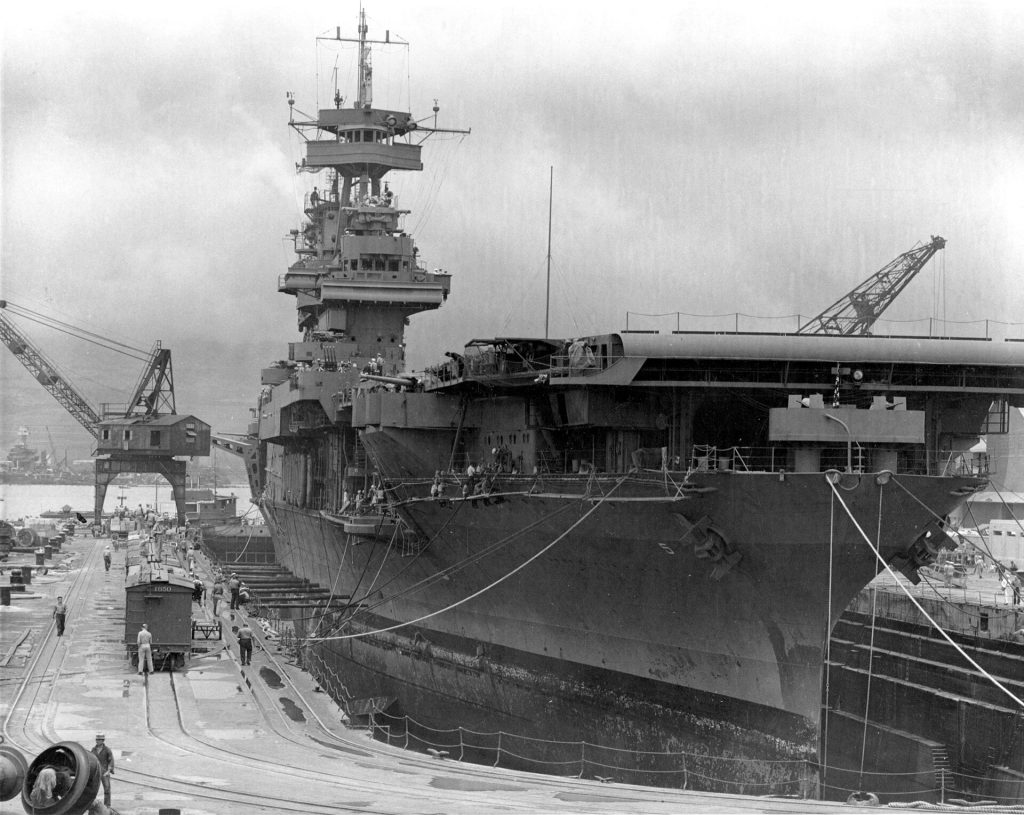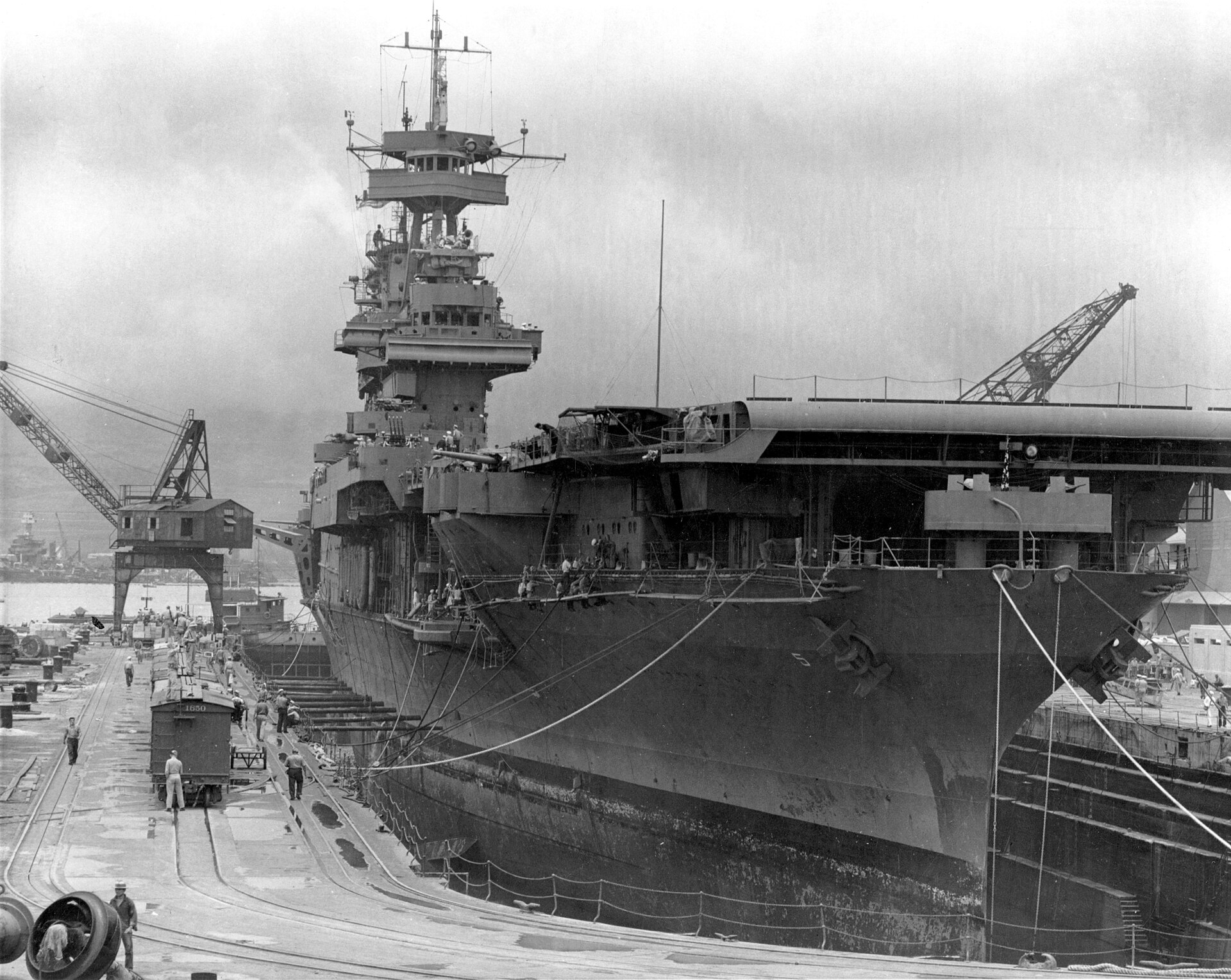In 2008 the Pearl Harbor Naval Shipyard celebrated its centennial. One-hundred years of active duty. With all the PR, symposiums, events, publications etc. I found no mention of the railroad at Pearl Harbor of the part it played in the shipyard’s history. There may be something I missed but this lack of information will now be corrected.
The United States Government acquired about 700 acres of land around Pearl Harbor and in 1908 construction of the Pearl Harbor Navy Yard was begun to include a dry dock and ship repair shops. Railroads were already an important part of Hawaii’s economy and the Oahu Railway and Land Company (OR&L) did a good business hauling construction materials, men and equipment to build the new Navy Yard. Benjamin Dillingham, the OR&L’s founder, had also founded Dillingham Construction which was involved with other contractors in the Pearl Harbor project. In those days “construction” meant steam, horse, mule and manpower. In particular, steam shovels, steam cranes, steam dredges, steam locomotives, muck or tipper cars and railroad tracks were required to build the Navy Yard and supplied by the contractors.
The Navy would also need a railroad in the yard to service the ships that would soon be calling for repairs, supplies and ammunition. In 1909 Navy Yard locomotive #1, a 0-4-0ST; construction number 4389 was built by H. K. Porter Co. and shipped to Pearl Harbor to help in building the yard. As construction of the Pearl Harbor Navy Yard continued, “Naval Station Pearl Harbor”, was established in 1912. A fiscal year 1913 appropriation for “Naval Station, Pearl Harbor, Railroad Equipment” amounting to $45,000.00 was authorized but exactly what railroad equipment was included is unknown. The appropriation did include at least one Brown Hoisting Machinery Company 15-ton locomotive crane for three-foot gauge railroad track and probably locomotive #2, a Vulcan Iron Works 0-4-0T built in 1913. Period pictures also show a number of flatcars, box cars and gondolas in service at the Navy Yard.
Additional construction was begun in 1912 adjacent to the Navy Yard of an elevated coaling plant to refuel warships and auxiliary vessels. This facility was built under an appropriation entitled “Depots for Coal” and eventually included six 15-ton, standard gauge, Brown Hoisting Machinery Company locomotive cranes, three standard gauge Vulcan Iron Works 0-4-0T’s, Navy Yard locomotives 3, 4 & 5, and a number of side dumping gondolas. This was the only standard gauge railroad built on Oahu, almost all else being 3-foot gauge, and was totally contained within the confines of Pearl Harbor naval complex. This era also saw the establishment of the “Magazine Reservation on Kuahua Island” and acquisition of a Porter 0-4-0 compressed air locomotive for use around the black powder ammunition of the day on this self contained railroad.
However, the magazine was soon linked by rail to the rest of the Pearl Harbor complex by a causeway. By early 1914 many of the repair shops were in place at the Navy Yard and the yard’s rail system fully operational. The construction of Dry Dock One was also well underway but a structural failure destroyed the floor and flooded the dock. The dock was rebuilt and the yard finally fully functional in 1919. Fortunately, the First World War had little effect on Hawaii and the Navy Yard’s facilities were not required during that conflict. 1919 also saw the establishment and construction of the “Naval Submarine Base” at Pearl Harbor and railroad operations within the base expanded to meet the increasing requirements. In these early days at Pearl Harbor, both the OR&L and the contractor’s trains were permitted access to the Navy Yard, the OR&L for interchange and the delivery of goods and contractors for construction of Dry Dock One and other Navy Yard structures, but the Navy recommended that money by made available to “remove the OR&L from the Station waterfront” and as a result, sometime after 1920, the OR&L was no longer allowed to operate within the Navy Yard.
An 18 car spur was installed adjacent to the Navy Yard, 5.6 miles from Honolulu and here the OR&L would set out cars for the Navy. Navy locomotives took over distribution within the Navy Yard and Naval Station. Navy locomotives were never permitted to operate on OR&L trackage without an OR&L conductor onboard and this occurred very rarely. The Navy’s rail system was operated by civilian government employees, not by active duty military personnel as was the case in the Army. By 1930, the number of buildings at the Navy Yard and the other commands at Pearl Harbor had nearly doubled and many additional spurs, sidings and a small yard had been added to the available narrow gauge trackage. At least eight navy locomotives were hard at work on the base as well as an unknown number of freight cars of various types.
In 1933, with the ever increasing size and importance of Pearl Harbor, the close proximity on Kuahua Island of large amounts of explosives to the ships and shops was considered to risky. To eliminate the hazard, the navy relocated the naval magazine, now known as “Naval Ammunition Depot (NAD) Oahu” and its railroad to a large tract of land containing 266 above and below ground magazines in the Lualualei Valley about 30 miles from Pearl Harbor. With the increasing tensions in the Pacific during the late 1930’s many orders for railroad equipment were placed by the military. Standard gauge crane orders were placed with the Ohio Locomotive Crane Company, narrow gauge crane orders were sent to the Orton Crane and Shovel Company. The trackage at the shipyard, Naval Station and submarine base had by this time been extended to virtually all the piers and repair basins. Many piers had both narrow and standard dual gauge tracks installed. As the Navy converted its ships from coal to oil in the 1920’s and 30’s, the importance of the coaling plant diminished and by 1939 the steam locomotive cranes were rarely seen at the coaling plant but could be found working on the various piers.
At the outbreak of World War Two the Navy’s rail system was as unprepared as the rest of the fleet and short on equipment. Huge freight car orders were placed by the Navy with many manufacturers on the mainland including the Pressed Steel Car Co. and Koppel Industrial Car and Equipment Co. Both of these companies supplied 60,000 lb. capacity steel flat cars and gondolas. Outside braced 60,000 lb. wood boxcars with arch bar trucks and steel frames also came from Pressed Steel Car Co. as well as all steel boxcars from Koppel. A number of tank car orders were also received from the American Car and Foundry Company. Other cars were ordered from various manufacturers. Most of these cars did not arrive until 1944 or 1945. The OR&L shops in Honolulu also built both standard design and specialized cars for the military prior to and during the war. To alleviate the critical railway equipment shortage at the beginning of the war the military searched the mainland. Second hand narrow gauge equipment in any condition from abandoned narrow gauge mainland roads and antique excess equipment from operating roads were sent to Hawaii.

Equipment was obtained from such diverse roads as the Nevada County Narrow Gauge, Rio Grande Southern, East Broad Top, Denver & Rio Grande Western, and Florence & Cripple Creek RR. This equipment included locomotives, freight and passenger cars. Among the most interesting oddities sent to Hawaii were the elderly, formerly electrified passenger cars of the Boston, Revere Beach & Lynn Railroad. These cars arrived in 1941, were re-lettered for the Navy, and with their wrought iron gates and folding steps intact, placed in passenger service within the Yard and housing areas.
The condition of these ancient passenger cars and those acquired from the East Broad Top prompted the Naval Station Commander, Rear Admiral Furlong, to forbid passengers to ride on the platforms. By the end of World War Two the Navy Yard rostered at least eight steam and eight diesel electric locomotives. Photography on any military base and the Honolulu piers was strictly prohibited during World War Two and most available pictures are either prior to or just after the war. Official Navy photographs that were taken in 1945 46 document the existing Navy Yard locomotives.
At least 29 locomotive cranes survived until the end of the war. With the end of the war much of the navy’s now excess equipment was sold or scrapped with the steam locomotives being among the first to go. Following the abandonment of the OR&L main line in 1947, the Navy took an option on the 30 miles of track between Lualualei and Pearl Harbor. At Pearl Harbor, use of the railroad had dwindled to almost zero by early 1949 and all 16 remaining navy locomotives were transferred to Lualualei. However, late in 1950, increasing tensions in the Far East involving Korea caused the Navy to begin an extensive upgrade of the remaining rail system and reactivation of numerous inactive diesel locomotives and pieces of rolling stock.
In 1951, the Pearl Harbor Naval Shipyard overhauled 164 flat cars in six weeks at an average cost of $600 each. During the Korean War, demands for ammunition shipments exceeded the capability of trucks and the Navy ammunition trains once again became a common sight. With the end of the Korean War, the railroad again fell into disuse. Through train operations to Pearl Harbor were suspended after a storm in November 1954 washed out a section of track on the line between Lualualei and West Loch, near Nanakuli and it was not until July 1956 that the line was again opened between Lualualei and West Loch to ease concerns about the traffic caused by heavy trucks carrying high explosives.
About the same time, the Navy abandoned the line from West Loch to Pearl Harbor as well as the Waikele spur and ceased all rail operations at Pearl Harbor.
